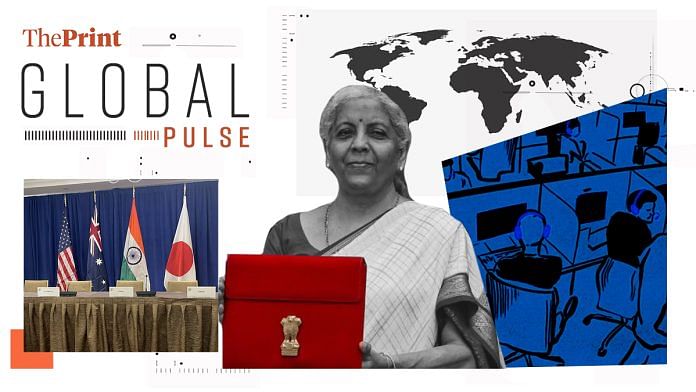New Delhi: As the Modi government prepares to present its first full-year budget in its third term, Bloomberg reminds its readers that India’s “pitch to the world” comes at a time when the global competitive landscape is disrupted.
The US is dangling a “deregulation carrot” and a “tariff stick”, while China is showcasing DeepSeek’s frugality while continuing to flex its economic muscle, writes Menaka Doshi in her newsletter for Bloomberg.
The budget, due on 1 February, will tell us how India is planning on pushing past its slowing growth—especially as the government is behind on its own target to be a $5 trillion economy by 2025.
“The answer may lie in one big success India can claim—of being a talent economy,” writes Doshi. “Where millions of English-speaking engineers and accountants in global capability centers are undertaking tasks that range from simple back office processes to complex design challenges for the world’s largest corporations.”
All of this is happening with very little help from the government, the newsletter notes. India’s IT services—its best-known export—had an organic start that’s similar to the $50 billion GCC sector, which has drawn foreign investment to India and created almost 2 million jobs. Both are less vulnerable to trade disruptions, as China lacks this manpower and the US doesn’t have highly skilled engineers.
“The lesson here is what can be achieved when the government isn’t looking,” the newsletter says. “It’s a win India could convert into a permanent feature—by doubling down on deregulation.” It adds that the government could better balance “the books between high government debt and insufficient revenue” by giving businesses more breathing room.”
Like Andy Mukherjee, a columnist for Bloomberg, reminds his reader—the “great unease” of doing business in India needs to change. If that happens, India will be able to “fight this period of hyper global competition at its fittest”.
The Economist prescribes another policy change in India to achieve more efficiency: “process reforms”, to streamline government bureaucracy. Small tweaks and changes instead of big ones are making a huge difference.
The process of closing a business, for example, was onerous: in 2021, it took 499 days on average. By 2024, it took only 99 days to close a business. Other agencies have also been either abolished or shrunk, like the Tariff Commission, the All-India Handloom Board, the All India Handicrafts Board and the Central Organisation for Modernisation of Workshop.
“There is much more to do,” The Economist writes. “Despite heavy investment in India’s ports, ships often get stuck waiting for customs and security clearances for their cargo. It can be so hard to claim any money from the Provident Fund, the national pension scheme, that many workers see contributions as a tax rather than a form of savings. But at least there is now a process for process reforms.”
Another story in The Economist says that the Quad is finally getting serious on security, and seems to be signalling a tougher approach to China.
The Quad began as a security partnership of countries wary of China’s rise, but has largely stayed away from explicitly military cooperation. The four countries do military exercises together, but don’t officially do military drills—it has recently mostly been confined to disaster relief and vaccine distribution. China might denounce the Quad as an “Asian NATO”, but based on its behaviour, the Quad seems to be having an identity crisis.
“Such pussyfooting is apparently out of fashion now that Donald Trump is back,” declares The Economist.
A day after his inauguration, Trump’s new secretary of state Marco Rubio hosted a meeting with the Quad’s foreign ministers, reaffirming their commitment to a “free and open Indo-Pacific where the rule of law, democratic values, sovereignty, and territorial integrity are upheld and defended.”
Many China hawks are delighted, the story says, because they see it as a clear signal that Trump is committed to the Quad—which is set to meet regularly before its next leaders’ summit in India.
“Still, a punchier Quad will prompt familiar concerns, especially for India. Mr Modi gets on well with Mr Trump and boosted defence ties with America following a deadly clash on the India-China border in 2020. But after reaching a deal on that border dispute in October 2024, Mr Modi wants to rebuild economic ties to China,” the story says.
Modi seems keen to please Trump, but India still remains opposed to a formal alliance with America—which could make it hard to upgrade quadrilateral military exercises, The Economist notes.
“Enlisting more partners and adding more data to that programme will help to refocus the Quad on security. Enhancing ‘Quad Plus’ activities involving other countries will help, too. The coalition will have to do much more to fulfil the promise of its January meeting. Achieving that may push India beyond its comfort zone. But it could finally transform the Quad into an effective check on China’s ambitions,” it predicts.
Meanwhile, the Financial Times asks an exhausted question: Is India the new China yet?
The FT admits that the “whole India versus China thing seems to be becoming a bit of a narrative”, And yet, global media can’t resist drawing the comparison.
It quotes an expert as saying China is facing a quadruple D of hurdles: Deflation, demographics, debt, and decoupling. As a result, as Chinese bonds plummeted, Indian bond yields have remained relatively high.
“However, the economic outlook for India is lot more positive than it is for China,” FT reports. The United Nations predicts that India will remain the fastest growing major economy in the world—forecasting a GDP growth of 6.6 percent in 2025 against Chinese growth of 4.8 percent.
“Of course, it wasn’t that long ago that people were just as bullish on China…” the article ends.






